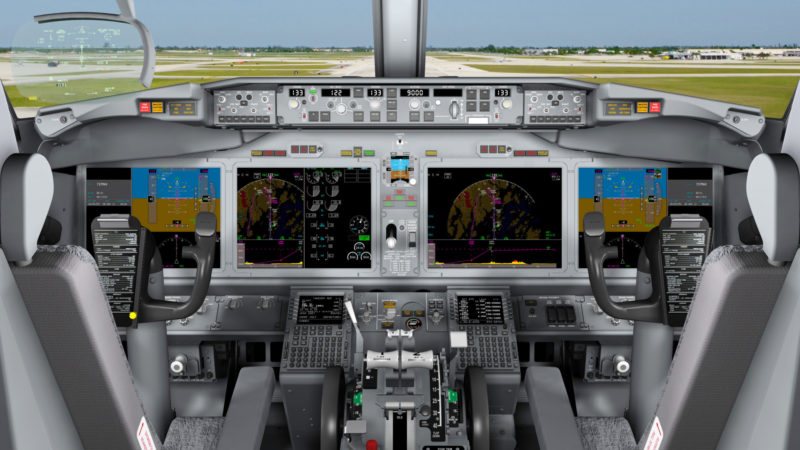
Boeing 737 MAX flight deck. Photo courtesy of Boeing
According to an internal company news memorandum obtained by Avionics, Boeing is launching a new business unit that will focus on development and production of avionics technology.
The world’s largest commercial airframe OEM already manufactures some of its own avionics, including computing systems, remote interface units and signal intelligence systems for commercial and military airframes. Currently 120 total employees work within Boeing’s enterprise avionics organization, and the plan is to add up to 480 new employees to that organization and get if fully staffed by 2019, according to Boeing.
The company’s new avionics team is focusing on developing new avionics technologies for “systems that are targeted for entry into service in the next decade,” the internal memo says. Recent quarterly earnings call comments by Boeing executives and a presentation on future aircraft and technologies at the 2017 Paris Air Show provide a preview for some of what that team will focus on.
In Paris, Mike Sinnett, VP of product development for Boeing Commercial Airplanes, said one of the world’s largest commercial airframe manufacturer’s future research focuses on three areas: autonomous taxi and flight control technology; machine learning; and high-integrity systems. This focus is primarily the result of Boeing’s latest commercial aviation market outlook, which projects demand for 41,030 new aircraft and 617,000 new pilots over the next two decades. Sinnett also discussed Boeing’s desire to increase overall autonomy in some of the safety-critical functionality of aircraft to supplement the need for new pilots.
Furthermore, the aviation industry and media have been anticipating an official announcement from Boeing about its next all new aircraft type, which has been rumored to be a middle of the market aircraft, which Boeing CEO Dennis Muilenburg directly addressed during its second quarter earnings call July 23.
“We continue to see a potential market there for 2,000 to 4,000 aircraft. We’re continuing to work our way through the details of what that airplane might look like potentially,” Muilenburg said, according to a transcript of the earnings call obtained from SeekingAlpha.com.
Boeing’s chief executive also noted that the company is looking at the overall supporting business case for building a new middle-of-the-market passenger aircraft. An important aspect of that, Muilenburg said, is “taking a look at the fundamental manufacturing system and how we design and build for the future and taking advantage of some of our new digital tools … That allows to take significant cost out of development, production and improve down field support.”
The new avionics division also aligns with Boeing’s new aircraft aftermarket services facility recently opened in Texas. By producing more avionics technology in house, that sets up more opportunities for Boeing to retain expertise in servicing those same avionics products once they enter service on new airframes and require maintenance and replacement as needed.
On the second quarter earnings call, when Muilenburg spoke about how the new aftermarket services division positions Boeing in competition with suppliers of avionics and other airframe systems and components, he said there will be competition as well as partnership opportunities.
“There are some places where we will logically have some competition between ourselves and our supply chain in terms of competing for certain service market segments,” he said. “In large part, this is about growing the market together and adding more value to our customers.”
One prominent supplier of avionics technology to Boeing over the last decade has been Honeywell Aerospace. During Honeywell’s own 2017 second quarter earnings call July 21, an analyst asked Honeywell’s CFO, Tom Szlosek, whether the new aftermarket services business from Boeing presented a risk to Honeywell’s own commercial avionics opportunities. Szlosek’s response occurred prior to the latest announcement of Boeing’s new avionics business, but indicates the company views it as more of an opportunity than a risk.
“In terms of exactly what’s going to happen and how they’re going to be going after their services business I think that’s yet to be find out. So, to me it isn’t that clear whether it’s an opportunity or a threat,” said Szlosek, also adding that Honeywell’s latest connected aircraft technology is “complementary toward Boeing.”
Rockwell Collins, Honeywell’s biggest competitor in commercial avionics manufacturing, also discussed some of Boeing’s further push into aftermarket services during its most recent third quarter earnings call. During Rockwell Collins’ third quarter, commercial aftermarket systems sales increased by $43 million compared to the same period in 2016, primarily due to “higher used aircraft equipment sales, higher regulatory mandate sales and higher spares provisioning,” said Kelly Ortberg, CEO of Rockwell Collins.
Boeing’s new avionics organization will be led by Allan Brown, who previously served as VP and program director for the missile defense national team within Boeing’s defense division.